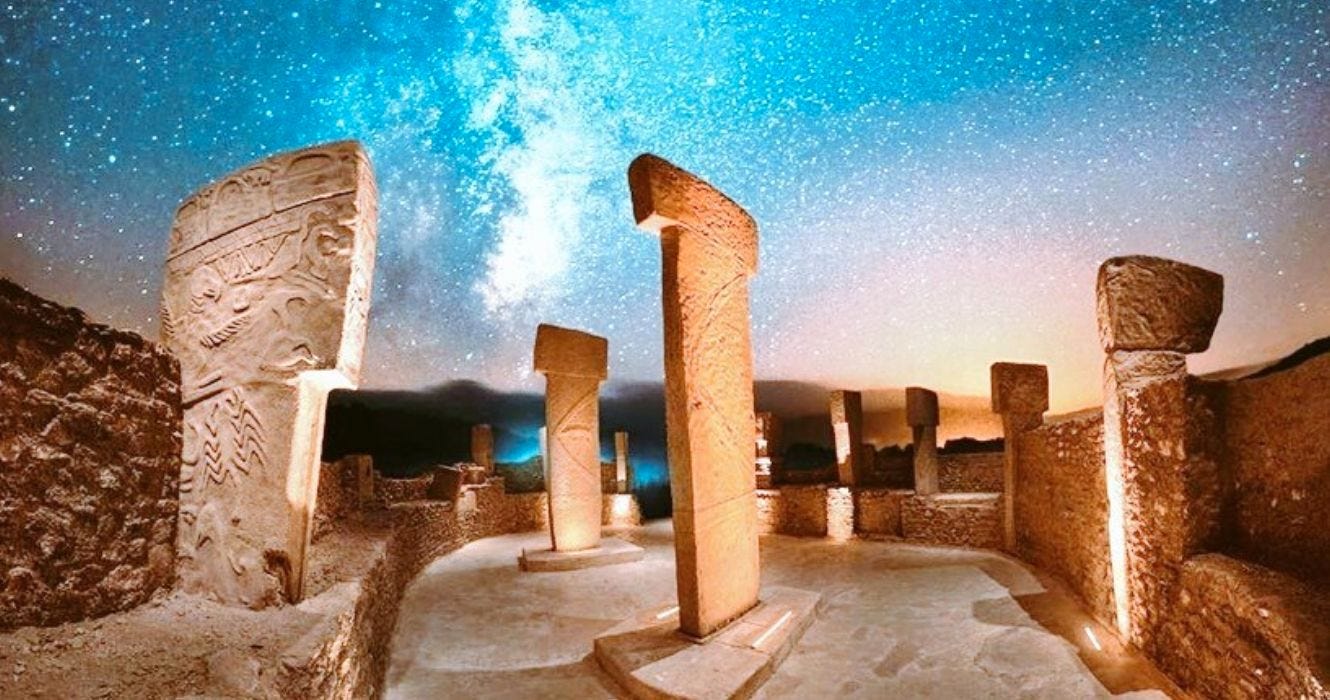Unintended Architecture
What We Desire is What We Build is What We Become
Recently I’ve been taking little moments to explore a different side of New York, the city I’ve called home for the last six years. When you see a city empty of people, you begin to understand the importance of architecture. You get to see the bones of the city, and you begin to understand what gives the flow of people shape, rhythm, energy.
You see, what we imagine becomes what build. And what we build manifests itself into what we experience. This is most immediately apparent in physical space, and many of us spending 24 hours a day in our homes are appreciating this now more than ever. But more importantly, when you build something, it doesn’t affect just you. It affects everything around you, diverting and re-directing flows of people, ideas, atoms, and stardust.
When we study ancient civilizations, we often rely on architecture to deduce how our ancestors lived.

An image of Göbekli Tepe in Turkey, sourced from thetravel.com
From architecture, we can begin to understand what our ancestors valued, what they worshipped, what technology they had, what knowledge they possessed, the relationships they had with themselves and with one another, and with nature and the divine.
But it also happens in digital space, and in spiritual and cultural space. What we build becomes what we are. And what we are influences what we build.
Architecture Dictates Form
Design is a universal language, one that transcends space and time. From form, we deduce function.
Architects design space for social experience. As a discipline, architecture combines the rigid rules of physics, mathematics, and material science with the fluidity and freedom of art, design, philosophy, and sociology.
This is why I love architecture - it reveals so much about the state of our world. It reveals our capabilities, our intentions, our desires. It changes our moods, our psyche, our way of moving and living.
The way we build has profound implications for the way we experience the world around us. If we build things that are open and inclusionary, we support the idea that we are a collective. If we build things that are exclusionary and divide people, we perpetuate the idea that we are separate tribes and groups.
In other words, borrowing from the Pritzker Prize, which is like the Nobel prize of architecture:
Society produces buildings, and the buildings, although not producing society, help to maintain many of its social forms.
These boundaries between rigid and fluid, between and closed, between restrictive and expressive, they can be physical - as in walls - but they can also be technical, political, emotional, and spiritual.
The present moment we’re experiencing is shaping our desire for the future. Maybe you’ve noticed the feelings you’re having about space and your desires for specific types of space. A desire for more expansive spaces and more open spaces. A drive for deeper connection with more empathy, patience, and compassion. A shift from transactional to emotional relationships. A forum for open communication and expression, or a shift from more formal scheduled conversations to more casual unstructured discussions on forums.
The New Architects: Digital Space as the New Frontier
The way we experience the world is no longer shaped only by the physical spaces we inhabit. The boundaries of our communications, transactions, and movements are defined by the digital infrastructure around us. With the proliferation of new platforms, new mediums, and new tools, we have built new operating systems for art, technology, finance, design, knowledge, communication, and more.
Think about the subtler architecture that is driving your behavior, driving your emotions, driving your beliefs. You’re reading this page - but how did you get here? Did you even know you wanted to be here before you arrived? Or did you wind up here, in spite of yourself?
The new architects shape your life in the digital world, controlling the width of the aperture through which you view the landscape around you, blurring and shifting the focus without you realizing it. They also shape your desires, your aspirations, your dreams, the products of your effort, your energy, and your precious time.
They’re building the infrastructure and interfaces that allow you to navigate, search, communicate, transact, and store information.
They’re calculating what information should be served to you and in what order in order to maximize your utility (to them as a human click farm)
They’re creating boundaries around what can and can’t be done, what can and can’t be said, where the lines should be (hint: it looks a lot like the old world).
They’re lobbying to destroy what little restraint they still have to exercise in their quest for domination and money and power.
And what’s so insidious in all of this is that the new architects can make you feel as though you’re living in a new world, in a new culture, when in fact nothing has changed at all. The new world is just a reflection of the old world, twisted and bent and warped, with more carefully crafted narratives that are perpetuated across more mediums.
I guess in a way, the future can never really escape the past. Because human knowledge is cumulative, everything new exists within the context of the old. From this point forward in human history, it will likely be impossible to forget anything, ever again.
But the fidelity of human history will still be subject to question.
Just like men kept letters to themselves for centuries, men and machines will hoard truth and twist it to the shape of their desire.

We live in a world that is defined by a certain set of rules and a certain architecture which has been ossified as more and more gets built within the existing system. To build a new system, we must fight to escape our predecessors not only with new products and services, but with new institutions, new policies, and new social and cultural values.

As a total aside, I think about this Ribbonfarm post at least once a month. It hits hard.
As Harold Bloom stated in the Anxiety of Influence, we must fight to escape our predecessors. What was possible in the past dictates our understanding of what is feasible in the future.
And this is what keeps me up at night. The gatekeepers of our world, whether the old, moneyed, political elite or our younger, omnipotent digital overlords, they have every incentive to keep us out or, even better, to make us believe that by changing our vision of the future, we can join their ranks. And if we build with their blueprints, the end result is the same.
Building Meaning: The Trajectory for Bitcoin
There’s this really interesting thing that happens when you’re building towards a vision. In a way, I think of entrepreneurs as people who create a reality distortion field. They paint a vision for a different version of reality, and if they can get enough people to believe in that vision and provide capital and influence, then it might actually become reality. In today’s age of influence, I actually think a founder’s most important job isn’t technical or skills based. It’s their ability to create a reality distortion field that is so strong that everyone who comes into contact with it cannot help but fall into the same distortion field.
In a way, I feel bitcoin has hit this point.
There are now millions of people who live in a distorted reality, one where bitcoin is a global store of value and a global financial network. We are in the midst of a renaissance, for people who have historically been excluded, for people who believe in something totally different, for people who have been left out of the design for the future. The battle now is for the narrative, what that future will look like.
This is why the march of Wall Street and Main Street into bitcoin is so dangerous, because it warps and changes our view of the future, sidelining our initial ambitions with something watered down. The presiding generation, the gatekeepers, they have to let the new thing happen. It’s a natural evolution, but people will inevitably fight it because it threatens their status. For the new generation, the challenge is wildly confusing — how do we allow this revolution to take place without watering it down?
As Karl Marx famously said “We are what we pretend to be, so we must be careful about what we pretend to be.” For a long time, we were pretending to be revolutionaries, and it was great fun because having an enemy is the best.
But now, we’re no longer the revolution. We’re becoming the establishment. When everyone is talking about bitcoin and Jamie Dimon says “I was wrong, bitcoin is amazing” and you deposit your bitcoin in his vaults, and there’s no one left to fight, what do we strive for?
Building for the Future
This is why I believe the future needs to look totally different than the past. We have to build new architecture, new idols, new ideals, to realize a new world.
What may come in the future doesn’t look like why it did in the past.
We have to break down those barriers and silos to make this possible. And that’s what architects do. Architects use science, math, design, and reason to build bridges, to build spaces, to build transitions from one world to the next.
Architects use tools with intention. From form, comes function.
Be careful what you aspire to build, and for whom.
You see, what we build manifests itself into what we experience.

It's nice to think we'll never be able to forget anything ever again, but the evidence is against you. An astonishing number of people don't know about Pearl Harbor. Our president is one of them. And his fans have already forgotten almost all of his personal history, because they don't want to remember it.
Also, back in the 1970's, John Berger made a persuasive case that physical architecture does not reflect society as a whole, but solely the moneyed classes. Only they can afford to hire architects to design and construct their vision of society's aspirations. It is very much a top-down operation, and as you suggest, may apply at least in part to digital architecture.